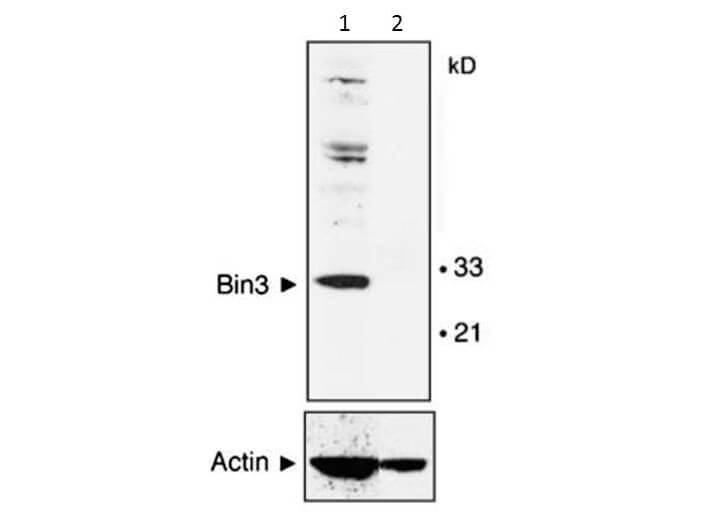Anti-BIN3 (MOUSE) Monoclonal Antibody
BIN3 Antibody
- SPECIFICATION
- CITATIONS
- PROTOCOLS
- BACKGROUND

| Host | Mouse |
|---|---|
| Conjugate | Unconjugated |
| Target Species | Human |
| Reactivity | Mouse |
| Clonality | Monoclonal |
Application
| WB, E, IP, I, LCI |
| Application Note | Anti-BIN3 antibody has been tested for use in ELISA, Western Blot, and IP. Specific conditions for reactivity should be optimized by the end user. |
| Physical State | Liquid (sterile filtered) |
| Buffer | 0.02 M Potassium Phosphate, 0.15 M Sodium Chloride, pH 7.2 |
| Immunogen | Anti-BIN3 (MOUSE) Monoclonal Antibody was produced in mouse by repeated immunizations with a full length human BIN3 recombinant protein followed by hybridoma development. |
| Preservative | 0.01% (w/v) Sodium Azide |
| Gene ID | 55909 |
|---|---|
| Other Names | 55909 |
| Purity | Anti-BIN3 was purified from clarified mouse ascetic fluid by Protein A chromatography followed by extensive dialysis against the buffer stated above. BIN3 antibody is specific for human BIN3 protein. A BLAST analysis was used to suggest cross-reactivity with BIN3 from human and mouse sources based on 100% homology with the immunizing sequence. Cross-reactivity with BIN3 from other sources has not been determined. |
| Storage Condition | Store vial at -20° C prior to opening. Aliquot contents and freeze at -20° C or below for extended storage. Avoid cycles of freezing and thawing. Centrifuge product if not completely clear after standing at room temperature. This product is stable for several weeks at 4° C as an undiluted liquid. Dilute only prior to immediate use. |
| Precautions Note | This product is for research use only and is not intended for therapeutic or diagnostic applications. |
| Name | BIN3 |
|---|---|
| Function | Involved in cytokinesis and septation where it has a role in the localization of F-actin. |
| Cellular Location | Cytoplasm, cytoskeleton. |
| Tissue Location | Ubiquitously expressed except in brain. |

Thousands of laboratories across the world have published research that depended on the performance of antibodies from Abcepta to advance their research. Check out links to articles that cite our products in major peer-reviewed journals, organized by research category.
info@abcepta.com, and receive a free "I Love Antibodies" mug.
Provided below are standard protocols that you may find useful for product applications.
Background
BIN-3 encodes an evolutionarily conserved and ubiquitously expressed member of the BAR superfamily of curved membrane and GTPase-binding proteins implicated in signal transduction and vesicular trafficking. In humans, Bin3 maps to chromosome 8p21.3, a region widely implicated in cancer suppression that is often deleted in non–Hodgkin’s lymphomas and various epithelial tumors. Study in mouse suggests that homozygous inactivation of Bin3 causes cataracts and an increased susceptibility to lymphomas during aging.
If you have used an Abcepta product and would like to share how it has performed, please click on the "Submit Review" button and provide the requested information. Our staff will examine and post your review and contact you if needed.
If you have any additional inquiries please email technical services at tech@abcepta.com.













 Foundational characteristics of cancer include proliferation, angiogenesis, migration, evasion of apoptosis, and cellular immortality. Find key markers for these cellular processes and antibodies to detect them.
Foundational characteristics of cancer include proliferation, angiogenesis, migration, evasion of apoptosis, and cellular immortality. Find key markers for these cellular processes and antibodies to detect them. The SUMOplot™ Analysis Program predicts and scores sumoylation sites in your protein. SUMOylation is a post-translational modification involved in various cellular processes, such as nuclear-cytosolic transport, transcriptional regulation, apoptosis, protein stability, response to stress, and progression through the cell cycle.
The SUMOplot™ Analysis Program predicts and scores sumoylation sites in your protein. SUMOylation is a post-translational modification involved in various cellular processes, such as nuclear-cytosolic transport, transcriptional regulation, apoptosis, protein stability, response to stress, and progression through the cell cycle. The Autophagy Receptor Motif Plotter predicts and scores autophagy receptor binding sites in your protein. Identifying proteins connected to this pathway is critical to understanding the role of autophagy in physiological as well as pathological processes such as development, differentiation, neurodegenerative diseases, stress, infection, and cancer.
The Autophagy Receptor Motif Plotter predicts and scores autophagy receptor binding sites in your protein. Identifying proteins connected to this pathway is critical to understanding the role of autophagy in physiological as well as pathological processes such as development, differentiation, neurodegenerative diseases, stress, infection, and cancer.


